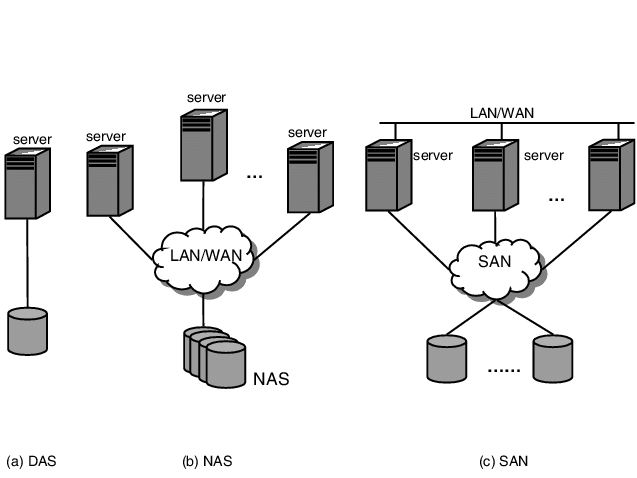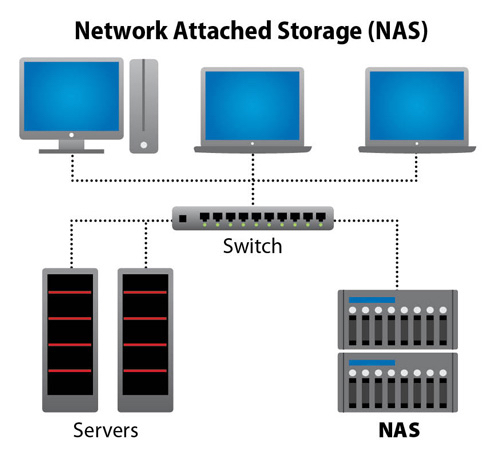
The three groups of words, NAS network storage, SAN, and DAS can be said to be a bit of a mistake and a thousand miles away. It’s like a girl asking you to repair a computer. The purpose of repairing the computer is the same, but their original intentions are different, and the methods of achieving them are different. The final result will be very different. For example, some guys may have a girlfriend after repairing the computer. Some guys may not find the girl’s purpose. Of course, it is also possible that she is really just looking for you to repair the computer.
Through this example, we look at NAS, SAN and DAS seems to be the same principle. NAS, SAN and DAS have the same purpose: storage. But the original intention, path and result are different.
Today, we will talk about these three girls: NAS, SAN and DAS.
NAS is the abbreviation of Network-Attached Storage. In simple terms, it is a device that achieves storage purposes through the network.
It has to be said that SAN and NAS are too similar, like a 69 relationship, even the letters are the same, but the composition is different. SAN, that is, Storage Attached Network.
And another DAS (Direct-Attached Storage), that is, open system direct-attached storage. The three storage terms are very similar, but express different storage states. In the following, we will start with the biggest differences among the three to help you distinguish the differences between the three.

DAS: A girl who you think day and night, but you don’t know her name
DAS is such a girl, you and she meet almost every day, but you never know her name. Because it is the storage in the personal computer, and it is a part of the server. The external storage device is directly connected to the application server through the SCSI or FC interface.
In fact, this DAS storage model is generally widely used in small and medium-sized enterprises. It relies more on the host’s operating system to implement data IO reading and writing, data management, and data backup.
But this storage mode also has certain shortcomings. For example, problems such as poor manageability, weak flexibility in expansion, and difficulty in keeping up with IT development trends. For example, a server/computer will only be equipped with fixed-capacity DAS storage. If the capacity is not enough and the storage space is too small, it is difficult to implement elastic expansion from the inside (external expansion capacity also has drawbacks), if the storage space Too big can also lead to waste of resources, which is especially obvious in the server field.

SAN: A very popular girl
I don’t know if you have ever met such a girl, generous, righteous, and aggressive, surrounded by a group of friends of the same age. SAN is this kind of girl, and it is precisely because of this characteristic of SAN that the shortcomings of DAS have been made up for.
SAN (Storage Area Network) is a mesh channel (FC for short) technology that connects storage arrays and server hosts through FC switches to establish an area network dedicated to data storage.
We can see from the definition that this is a storage method dedicated to enterprise-level applications. It can be simply understood as a high-level network that provides data transmission between the computer and the storage system.
In theory, SAN supports hundreds of disks, provides massive storage space, and solves the problem of large-capacity storage; at the logical level, this massive space can be divided into LUNs of different sizes as needed, and then allocated to servers. Solve the problem that only small capacity storage is needed.
It can be said that the emergence of SAN has adapted to the general trend of information development. It separates computing from storage and enhances the flexibility of storage expansion. After all, nowadays there are more and more networked devices, the amount of data is getting bigger and bigger, and our storage needs are getting stronger and stronger. The SAN’s “collaboration” feature makes storage more flexible and more convenient for capacity expansion.
At the same time, due to the unique storage structure, SAN needs to connect storage arrays and servers through fiber optic switches to establish a dedicated data storage network.

NAS: Inviting people from the world
NAS is the kind invitation of many people. It has its own operating system and its own storage space. It contains many “master” secrets.
NAS can be simply understood as a convenient local area network storage device, a device that achieves storage purposes through the network.
NAS (Network Attached Storage) is a standard file-level storage method. It uses network technologies (TCP/IP, ATM, FDDI) to connect the storage system and the server host through a network switch to establish a storage private network. Its main feature is to integrate storage devices, network interfaces and Ethernet technology, and access data directly through the Ethernet network. It can quickly achieve department-level storage capacity requirements and file transfer requirements.
Compared with the above two, NAS network storage has more independence and good compatibility. It not only has its own operating system, but also can be used in a mixed Unix/Windows NT LAN without modification. It is compatible with various operating systems and has good flexibility.

In addition to having their own characteristics, the three girls will complement each other. Just as SAN often becomes the “backer” of NAS, the three girls rely on each other to reach the best solution. Well-known brands have prepared powerful storage devices, such as HPE, Dell, Huawei and so on. Welcome to order!
Related Topics:
Buyer Guide: How to Select Storages for the Enterprise?
Top-rated HPE DL380, DL360 Servers and MSA Storage



